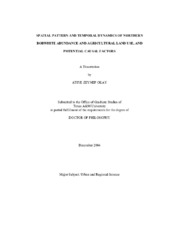| dc.contributor.advisor | Sullivan, Arthur L. | |
| dc.contributor.advisor | Wu, X. Ben | |
| dc.creator | Okay, Atiye Zeynep | |
| dc.date.accessioned | 2006-04-12T16:07:09Z | |
| dc.date.available | 2006-04-12T16:07:09Z | |
| dc.date.created | 2004-12 | |
| dc.date.issued | 2006-04-12 | |
| dc.identifier.uri | https://hdl.handle.net/1969.1/3355 | |
| dc.description.abstract | There was a long-term decline in northern bobwhite (Colinus virginianus, NBW)
abundance since the 1920s, based on the Christmas Bird Count (CBC) data, but with
substantial spatial and temporal variations across its range. There were four
recognizable periods in the spatial and temporal dynamics of NBW abundance between
1920 and 1990. Severe weather conditions and habitat loss due to land use change
appeared to be the most important factors influencing the long-term trends and spatial
patterns in NBW abundance.
A spatial database of agricultural land use was developed based on the Census of
Agriculture to evaluate the spatial patterns of land use variables over NBW range from
1920 to 1997. The results showed dramatic changes in land use over the period and the
influence of socio-economic events, natural disasters and federal agricultural policies on
the dynamics of land use pattern, and potential implications to NBW abundance were
identified. Replacement of less intensive agriculture with intensive monoculture
production and mechanization coincided with World War I, and the post-war collapse in
agriculture and the economy, partly associated with the Dust Bowl, enhanced this trend.
Monoculture production and clean farming practices were further intensified during
World War II and the years following the war. These land use changes had overall
negative effects on NBW habitat.
Analysis of the changes in spatial pattern of NBW abundance in the Great Plains
region during the severe drought of the 1950s showed a significant decline in NBW
abundance during the drought and a contraction of the NBW range at its western edge.
The post-drought recovery exhibited spatial patterns significantly different from the predrought
ones. These findings suggested that severe drought caused short-term changes
in regional distribution of NBW and range contraction, as well as long-lasting, largescale
changes in spatial distribution of NBW abundance.
This study provides scientific basis for landscape planning and management.
Evaluating the spatial pattern and temporal dynamics of certain wildlife species at large
scales over long-term periods, and identifying potential causal factors are key strategies
for implementing innovative and sustainable approaches to planning and policy. Such
strategies will have a significant impact on future landscape and wildlife species. | en |
| dc.format.extent | 8341699 bytes | en |
| dc.format.medium | electronic | en |
| dc.format.mimetype | application/pdf | |
| dc.language.iso | en_US | |
| dc.publisher | Texas A&M University | |
| dc.subject | Urban and Regional Science | en |
| dc.subject | Ecology | en |
| dc.subject | Agriculture | en |
| dc.subject | Forestry and Wildlife | en |
| dc.subject | Biology | en |
| dc.title | Spatial pattern and temporal dynamics of northern bobwhite abundance and agricultural landuse, and potential casual factors | en |
| dc.type | Book | en |
| dc.type | Thesis | en |
| thesis.degree.department | Landscape Architecture and Urban Planning | en |
| thesis.degree.discipline | Urban and Regional Science | en |
| thesis.degree.grantor | Texas A&M University | en |
| thesis.degree.name | Doctor of Philosophy | en |
| thesis.degree.level | Doctoral | en |
| dc.contributor.committeeMember | Wunneburger, Douglas | |
| dc.contributor.committeeMember | Smeins, Fred | |
| dc.contributor.committeeMember | Peterson, Markus | |
| dc.type.genre | Electronic Dissertation | en |
| dc.type.material | text | en |
| dc.format.digitalOrigin | born digital | en |


